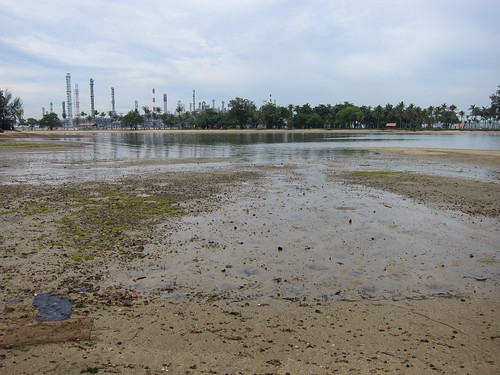Impact of fluorosurfactants
 October 2, 2011
October 2, 2011
Latest media reports say that while “the fire at the Shell refinery on Pulau Bukom has been fully extinguished, SCDF is still continuing foaming operations as there are still traces of fuel vapour in the affected areas.” In light of this, I thought it would be useful to find out more about fire fighting foam.
What is fire fighting foam?
Fire fighting foam is a foam used for fire suppression. Its role is to cool the fire and to coat the fuel, preventing its contact with oxygen, resulting in suppression of the combustion. The surfactants used need to produce foam in concentration of less than 1%. Other components of fire retardant foams are organic solvents (e.g. trimethyltrimethylene glycol and hexylene glycol), foam stabilizers (e.g. lauryl alcohol), and corrosion inhibitors. Wikipedia
What are the different types of foam?
Class A foams: developed in mid 1980s for fighting wildfires. Class A foams lower the surface tension of the water which assists in the wetting and saturation of Class A fuels with water.
Class B foams: designed for class B fires — flammable liquids. The use of class A foam on a class B fire may yield unexpected results, as class A foams are not designed to contain the explosive vapors produced by flammable liquids. Class B foams have two major subtypes.
- Synthetic foams are based on synthetic surfactants. Synthetic foams provide better flow, faster knockdown of flames, but limited post-fire security. Two main types of synthetic foams are:
- Aqueous film forming foams (AFFF) are water-based and frequently contain hydrocarbon-based surfactant such as sodium alkyl sulfate, and fluorosurfactant—such as fluorotelomers, perfluorooctanoic acid (PFOA), or perfluorooctanesulfonic acid (PFOS). They have the ability to spread over the surface of hydrocarbon-based liquids.
- Alcohol-resistant aqueous film forming foams (AR-AFFF) are foams resistant to the action of alcohols, able to form a protective film when they are present.
- Protein foams contain natural proteins as the foaming agents. Unlike synthetic foams, protein foams are bio-degradable. They flow and spread slower, but provide a foam blanket that is more heat resistant and more durable. Protein foams include regular protein foam (P), fluoroprotein foam (FP), film forming fluoroprotein (FFFP), alcohol resistant fluoroprotein foam (AR-FP), and alcohol-resistant film forming fluoroprotein (AR-FFFP).
What is the environmental impact of AFFF?
Fire fighting foams, whether or not they contain fluorinated materials, have acute toxicity towards the aquatic environment as detergents. They also deplete oxygen levels, required for biological degradation. Finished fluorosurfactant foams are generally rather non-toxic; however, it is their polyfluorinated degradation products that are of environmental concern because of unfavourable persistence, bio-accumulation and toxicity (PBT). Bio-accumulation and toxicity depend critically on the chain length and structure of the degradation product. Extreme persistence, however, is a general property shared by all perfluorinated degradation products whether derived from PFOS- or fluorotelomer-based foams. Indeed perfluorocarbon derivatives are some of the most environmentally persistent known – CF4 is estimated as having an atmospheric lifetime of between 10,000 and 20,000 years, and there is no known degradative pathway for trifluoroacetic acid, CF3COOH, in the aqueous environment.
Why use fluorosurfactants when it’s harmful for the environment?
The extreme chemical stability of fluorosurfactants and their degradation products is both a boon and a bane. Their use for fire fighting foam depends on both their excellent stability and efficiency as surface active (wetting) agents. Although very expensive on a weight basis compared to hydrocarbon or silicon-based surfactants, their effectiveness at low concentrations results in a favourable cost per unit volume of finished foam.
Case studies
The Allied Colloids fire in 1992 near Bradford UK resulted in tens of millions of litres of foam and chemically contaminated run-off being discharged into the local river system, since not to have done so would have destroyed the local foul water treatment plant. The immediate effect was to render the river system biologically dead for some 50 km downstream.
What are others doing about this?
- In 2000, 3M Company decided to discontinue the manufacture of PFOS-based fluorosurfactants including AFFF for firefighting on environmental grounds
- The 1979 European Council Directive (80/68/EEC 17 December 1979) – the
European Groundwater Directive – forbids the discharge of organohalogens or
degradation products that are organohalogens to groundwater. The Environmental Impact of Fire Fighting Foams: Operational and legal implications

 Posted in
Posted in 



 content rss
content rss
COMMENTS